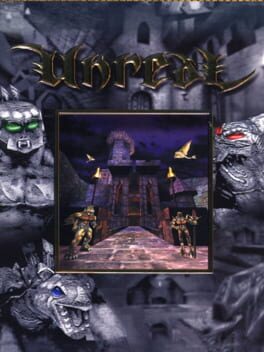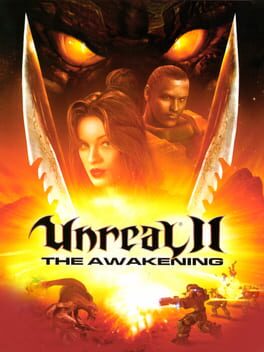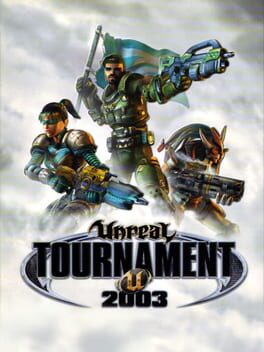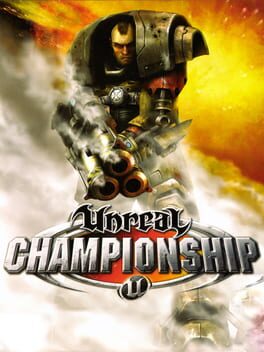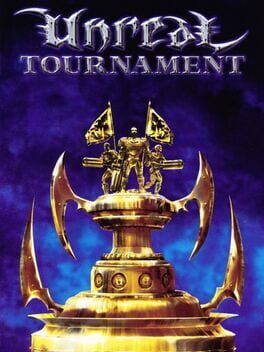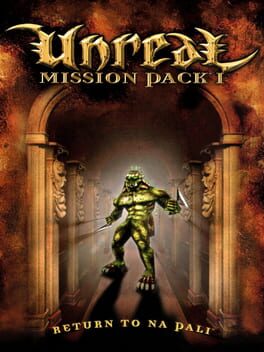

Your prison ship has crash-landed on the fastest, sleekest, most dangerous 3D world ever created. Look around, crystal clear water shimmers, shadows dance and shift, alien architecture fades into the horizon. Discover the secret of this mysterious planet and find out what caused a peaceful race to be enslaved by vicious merciless aggressors.
Also in series
Reviews View More
Really wanted to like this one, but couldn’t really bring myself to finishing it. Unreal is kind of a half-step in between Quake and Half-Life, which led to me wishing I could just play either of those games the entire time. To give this game (or at least, its engine) some credit, I have been enjoying the Unreal Tournament games WAY more than this single player campaign. So there is good gameplay (and gunplay) here, this campaign just isn’t for me
For many of the great FPS games of the 1990s, I think perhaps the very last thing on a player's mind was the story. In Wolfenstein, you were killing Nazis. In Doom, you were killing demons. In Duke Nukem, you were killing aliens. The narrative didn't really matter until 1998, when two games took a major leap forward in single-player storytelling. One of those games was Half-Life, and the other... Unreal. This game also introduced the iconic game engine of the same name, that many games since have made use of. I was never quite as immersed in an action game like this until Unreal. Reading through the apocalyptic logs of people who had traversed the alien planet just before me exposed riveting and often tragic stories. And each level you go through has brilliant environmental storytelling, giving you all you need to know about the where and why of your journey. And then, of course, there's the gunplay with some truly inventive weapons, from a 6-barrelled rocket launcher, an explosive acid gun, and a laser pistol that can be upgraded into a potent killing machine if you look around enough. And I haven't even mentioned the great multiplayer maps or that the campaign is extremely co-op friendly! Flashier games have come since, but nothing will ever top this Unreal experience.
It's unreal how your entire arsenal is useful in this game, no gun is redundant or useless. The ever-changing scenarios encourage you to swap weapons often and make use of the different options available. A lot of the foes can dodge your shots and move in unpredictable ways, while the bulk of damage is done by projectile weapons. This creates situations in which short-term planning is essential according to the type of enemy you’re facing. Some of the monsters, for example, start attacking from mid-range and attempt to get in your face as you back away. You can’t use explosive weapons when a 3-meter beast has its crotch pressed against your head, or else you would take severe damage. A good course of action is dealing enough explosive damage while the enemy is far away so that you can finish it off with a flak cannon (shotgun, basically) when it's up close. Of course, since the AI will almost always attempt to dodge your rockets/grenades, you should try forcing it into a situation in which it doesn’t have room to move away. If there’s more than one enemy, you might want to prioritize the ones which do more damage; or find ways to damage multiple at the same time. In a vacuum, this works well, creating a combat loop that is less about managing hordes or reacting to predictable patterns, and more about quickly adapting to factors outside of your immediate control to take back dominance over the playing field. Your enemies can take a lot of hits, so a fight against even one, depending on the context, can be a real struggle. The problem with Unreal’s combat is that the level design doesn’t always support its unique enemy behavior.
When the area of play is too expansive, most of the interesting mechanics are nullified, since both you and your enemies have functionally infinite space to avoid projectiles. Hitscan weapons become your most reliable solution. Monsters, however, are stuck with projectile-based attacks, so the encounter becomes tensionless, as nothing is being actively fought over.
A claustrophobic area can work, as long as it draws the players in instead of pushing them away. There are a lot of opportunities to corner the AI, but you’re equally susceptible to having your movement options restricted. Tight spaces test the player’s quick-thinking skills and smart use of the environment. You want to keep the monster at medium range while utilizing the level geometry and movement to avoid damage. Sometimes, though, you have to force yourself into uncomfortable situations to fully enjoy this type of design. It’s too easy for the player to take an overly defensive approach and not even enter the stage, standing by the entrance and engaging with the enemy from behind a safe corner. To avoid this, the designer could attract the player into the battlefield by providing a safe area inside the field itself (such as cover), or introduce the enemies only after the player is already in the middle of the stage, perhaps in a more challenging position. The key is to make players move around and strategize a short-term course of action. Locking the exits can feel cheap if the game puts emphasis on organically exploring the environment, you don’t want to take away too much agency. The other solutions work by letting the player be a protagonist of their experience while still leading them to interesting scenarios.
This game would benefit from stages structured more like smaller, less cyclical multiplayer levels. A larger area consisting of a series of interconnected tight or slightly open sections that allow for layered options of engagement with the enemy. The loop asks for creative use of the environment, so geometry is key. Different levels of verticality, narrowness and amount of cover could all be used to define battles, but zones this thought-out are rare and isolated.
Outside of combat, stages consist of the classic old rhythm of finding triggers to unlock the rest of the level, which forces exploration and clever analysis of the environment. I am terrible navigating most games that use this structure, so it may be a personal issue, but I found Unreal to be very confusing at times. For a good portion of my playthrough, I was ready to praise the game for always, somehow, leading me to the right path and guaranteeing steady progression without requiring me to bang my head against the wall. After many moments stuck, however, I realized that I only had that impression because I had happened to bang my head against the right walls by luck. The set of actions you’re required to figure out and perform get more complicated as the levels grow. By the last third, you’re swimming through sewers and running back and forth between castles, outposts and houses in order to find the one lever you haven’t pushed to activate a lift on the other side of the map. The tips that appear on the translator help, but they can’t replace clear, well-signposted design, which is mostly lacking. It’s Unreal-istic to expect the player to keep track of every door they must backtrack to in order to progress. When you flip a switch, you shouldn’t be left wondering what in god’s name it did. To avoid confusion, it’s good, for example, to make sure the player has a view of the section they’re altering when activating a trigger.
The game maintains a very strong visual cohesion while keeping levels diverse and innovative. It’s truly unreal just how varied the areas can look, considering the game is quite long (I took a few screenshots to exemplify - https://imgur.com/a/jPsmllp). The aesthetic vision incorporates ancient dungeons, sci-fi motherships and organic forest environments into a believable, consistent world. The striking art direction is a solid foundation for its universe. The concept alone is already half the world-building: peaceful natives inhabit a functioning ecosystem, living in harmony with the forces of nature, only to have their way of life destroyed and exploited by foreign, technologically oppressive invaders. The rest is detailed by clever set dressing and rare but remarkable written content. Experiencing a story through observation helps construct a believable environment. Also, it’s interesting how small you are compared to the rest of the creatures, it helps sell the idea that you are an alien in this world.
The soundtrack manages to translate a world of jungles, ancient principles and alien technology into a dense atmosphere. The more ambient tracks remind me of a modern vaporwave album, テレパシー能力者 : ロストエデンへのパス by Telepath and Nmesh, which also establishes an unreal, dream like ambience thematically focused on nature.
Unreal had everything to develop impeccable, intensely memorable combat encounters, but the rarity of stage design that understands its own enemies severely hurts its potential. It’s still a very fun experience that manages to keep itself entertaining even during the boring gameplay sections. The art direction is so cohesive and aesthetically pleasing, it’s unreal!
When the area of play is too expansive, most of the interesting mechanics are nullified, since both you and your enemies have functionally infinite space to avoid projectiles. Hitscan weapons become your most reliable solution. Monsters, however, are stuck with projectile-based attacks, so the encounter becomes tensionless, as nothing is being actively fought over.
A claustrophobic area can work, as long as it draws the players in instead of pushing them away. There are a lot of opportunities to corner the AI, but you’re equally susceptible to having your movement options restricted. Tight spaces test the player’s quick-thinking skills and smart use of the environment. You want to keep the monster at medium range while utilizing the level geometry and movement to avoid damage. Sometimes, though, you have to force yourself into uncomfortable situations to fully enjoy this type of design. It’s too easy for the player to take an overly defensive approach and not even enter the stage, standing by the entrance and engaging with the enemy from behind a safe corner. To avoid this, the designer could attract the player into the battlefield by providing a safe area inside the field itself (such as cover), or introduce the enemies only after the player is already in the middle of the stage, perhaps in a more challenging position. The key is to make players move around and strategize a short-term course of action. Locking the exits can feel cheap if the game puts emphasis on organically exploring the environment, you don’t want to take away too much agency. The other solutions work by letting the player be a protagonist of their experience while still leading them to interesting scenarios.
This game would benefit from stages structured more like smaller, less cyclical multiplayer levels. A larger area consisting of a series of interconnected tight or slightly open sections that allow for layered options of engagement with the enemy. The loop asks for creative use of the environment, so geometry is key. Different levels of verticality, narrowness and amount of cover could all be used to define battles, but zones this thought-out are rare and isolated.
Outside of combat, stages consist of the classic old rhythm of finding triggers to unlock the rest of the level, which forces exploration and clever analysis of the environment. I am terrible navigating most games that use this structure, so it may be a personal issue, but I found Unreal to be very confusing at times. For a good portion of my playthrough, I was ready to praise the game for always, somehow, leading me to the right path and guaranteeing steady progression without requiring me to bang my head against the wall. After many moments stuck, however, I realized that I only had that impression because I had happened to bang my head against the right walls by luck. The set of actions you’re required to figure out and perform get more complicated as the levels grow. By the last third, you’re swimming through sewers and running back and forth between castles, outposts and houses in order to find the one lever you haven’t pushed to activate a lift on the other side of the map. The tips that appear on the translator help, but they can’t replace clear, well-signposted design, which is mostly lacking. It’s Unreal-istic to expect the player to keep track of every door they must backtrack to in order to progress. When you flip a switch, you shouldn’t be left wondering what in god’s name it did. To avoid confusion, it’s good, for example, to make sure the player has a view of the section they’re altering when activating a trigger.
The game maintains a very strong visual cohesion while keeping levels diverse and innovative. It’s truly unreal just how varied the areas can look, considering the game is quite long (I took a few screenshots to exemplify - https://imgur.com/a/jPsmllp). The aesthetic vision incorporates ancient dungeons, sci-fi motherships and organic forest environments into a believable, consistent world. The striking art direction is a solid foundation for its universe. The concept alone is already half the world-building: peaceful natives inhabit a functioning ecosystem, living in harmony with the forces of nature, only to have their way of life destroyed and exploited by foreign, technologically oppressive invaders. The rest is detailed by clever set dressing and rare but remarkable written content. Experiencing a story through observation helps construct a believable environment. Also, it’s interesting how small you are compared to the rest of the creatures, it helps sell the idea that you are an alien in this world.
The soundtrack manages to translate a world of jungles, ancient principles and alien technology into a dense atmosphere. The more ambient tracks remind me of a modern vaporwave album, テレパシー能力者 : ロストエデンへのパス by Telepath and Nmesh, which also establishes an unreal, dream like ambience thematically focused on nature.
Unreal had everything to develop impeccable, intensely memorable combat encounters, but the rarity of stage design that understands its own enemies severely hurts its potential. It’s still a very fun experience that manages to keep itself entertaining even during the boring gameplay sections. The art direction is so cohesive and aesthetically pleasing, it’s unreal!
This was a surprising game for me in many ways. The game starts out in a decently atmospheric intro level where you find yourself escaping a crashed prison spaceship, lacking weapons, can read logs and notes from all the dead people and abandoned computers around you and get the chance to pick up the pieces to get some context for the story. Eventually when stepping out into the planet, the gigantic scale of the map, the ambient sounds coming from the animals and environment and the sense of exploration were incredible.
Many maps in this game have an incredible scale for 1998, and even when things are crude, a lot of thought goes into the world building be it through readable logs or simply environmental details. You could call the visuals outdated, but I find that they're artistically used very well to convey the environment so that I could keep myself immersed even when details are lacking, especially thanks to some great use of lighting effects. Some of the scenes visible in this game are simply unbelievable to me and I can't imagine what seeing them in a period accurate PC at the time would have been like.
Combat is certainly an aspect that will put a lot of people off, they focused on building an AI system that would give enemies the ability to navigate maps extensively, dodge your attacks and even have some types use a variety of weapons. I'm guessing that due to optimization, they kept combat spaces to very few enemies at a time which does mean enemies are designed around being a bit tanky so you often have a dynamic 1v1 encounter. When it works it's pretty fine, if a bit slower paced than other games in the genre at the time, but when it doesn't work it feels like enemies are either always dodging or getting lost, with the level design in later areas not helping much as it gets more mazey.
And this is where the game fell out of legendary status for me, the jank felt pretty justifiable given its age and how much it accomplished at the time a mere 5 months after Quake II had tried to do a lot of it and didn't quite reach, but the final 2 chapters are extremely tedious. Level design goes from trying to immerse into big open maps that lead you to smaller places you can explore to being very mazey and in some cases a messy kind of symmetrical, with very strange design choices like waiting for 2 enemies to constantly spawn after being killed until they spawn behind a door, with no indication, so that door finally opens and you can proceed. Already I felt like the game was simply stretching thin before this as it ran out of weapons and enemies to introduce, but the final chapter had me WISHING the game ended in every single map I had to go through. It didn't help that boss fights are the typical FPS trope of shoot at it until it dies.
I don't mind Half-Life Xen as much as other people do, I find it kinda boring but not frustrating. The final chapter of Unreal was frustating for me, not because it had weird gravity gimmicks or because I died much or anything of the sort, but because the levels and enemy encounters were really unengaging and uninteresting at that point. As even story logs became rare, I felt like the game should have ended 2 or 3 hours ago already. I do not think getting bang for your buck in game length is worth it if the game isn't offering more fun, just more filler. At the very least Xen was filled with interesting ideas and Half-Life wasn't as long.
Still with the problems I had at the end I'm very glad I played this, I still find it an impressive title full of memorable places to explore and a surprisingly thought out world. I just wish it wasn't stretched so much at the end, but regardless, it is a good game and it's a shame that Epic cannot see it for what it is and would rather delist it because they refuse to provide support the community is more than happy to do for them, even while being unpaid.
Many maps in this game have an incredible scale for 1998, and even when things are crude, a lot of thought goes into the world building be it through readable logs or simply environmental details. You could call the visuals outdated, but I find that they're artistically used very well to convey the environment so that I could keep myself immersed even when details are lacking, especially thanks to some great use of lighting effects. Some of the scenes visible in this game are simply unbelievable to me and I can't imagine what seeing them in a period accurate PC at the time would have been like.
Combat is certainly an aspect that will put a lot of people off, they focused on building an AI system that would give enemies the ability to navigate maps extensively, dodge your attacks and even have some types use a variety of weapons. I'm guessing that due to optimization, they kept combat spaces to very few enemies at a time which does mean enemies are designed around being a bit tanky so you often have a dynamic 1v1 encounter. When it works it's pretty fine, if a bit slower paced than other games in the genre at the time, but when it doesn't work it feels like enemies are either always dodging or getting lost, with the level design in later areas not helping much as it gets more mazey.
And this is where the game fell out of legendary status for me, the jank felt pretty justifiable given its age and how much it accomplished at the time a mere 5 months after Quake II had tried to do a lot of it and didn't quite reach, but the final 2 chapters are extremely tedious. Level design goes from trying to immerse into big open maps that lead you to smaller places you can explore to being very mazey and in some cases a messy kind of symmetrical, with very strange design choices like waiting for 2 enemies to constantly spawn after being killed until they spawn behind a door, with no indication, so that door finally opens and you can proceed. Already I felt like the game was simply stretching thin before this as it ran out of weapons and enemies to introduce, but the final chapter had me WISHING the game ended in every single map I had to go through. It didn't help that boss fights are the typical FPS trope of shoot at it until it dies.
I don't mind Half-Life Xen as much as other people do, I find it kinda boring but not frustrating. The final chapter of Unreal was frustating for me, not because it had weird gravity gimmicks or because I died much or anything of the sort, but because the levels and enemy encounters were really unengaging and uninteresting at that point. As even story logs became rare, I felt like the game should have ended 2 or 3 hours ago already. I do not think getting bang for your buck in game length is worth it if the game isn't offering more fun, just more filler. At the very least Xen was filled with interesting ideas and Half-Life wasn't as long.
Still with the problems I had at the end I'm very glad I played this, I still find it an impressive title full of memorable places to explore and a surprisingly thought out world. I just wish it wasn't stretched so much at the end, but regardless, it is a good game and it's a shame that Epic cannot see it for what it is and would rather delist it because they refuse to provide support the community is more than happy to do for them, even while being unpaid.
